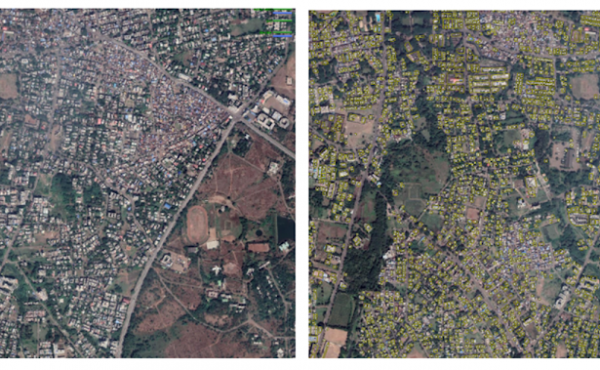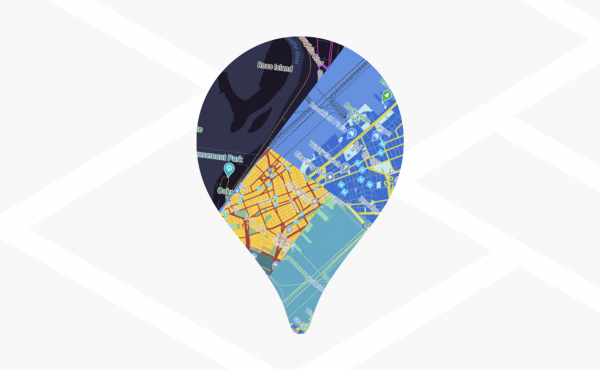Google’s Maps data: How does it work?
New Maps customization features by Google Maps Platform
People all around the world use Google Maps to meet their routine needs from finding the nearest open hospital to building a route to the destination place. Being added some more advanced features like points of interest (POIs) or some contextual data, these core functions of Maps are able to help users in gazillions of situations, which are much more complicated than finding the shopping mall nearby. Today we’d be happy to tell you about 5 new Maps customization features that’ll be a helping hand in creating deeply customized maps. We will also recount a new way of seamless adoption of these and further upgrades.
Maps customization, styling, and management in the cloud
Some time ago companies had a need to use the hand-code HTML websites, sooner came the robust tools that turned website content management into a task that didn’t require an engineer. Moreover, the content and the context became fresher since then. So, following the evolving challenges of the clients Google decided to take measures of moving in the cloud-based customization direction. Now Google Maps Platform users can manage and customize their maps via the Google Cloud Console. This brand new way has its benefits. The prime examples are: more customization capabilities, easier management, and faster deployment of tests and new features.
Before this update customers had to manage their Maps solutions by means of client-side JSON that was then sent to the server of map requests. This way was not convenient, because the number of the customization capabilities was restricted due to the URL limits. Considering the customer experiences of being bounded customizing the map, Google has already transferred all the styling features to the cloud-based solution. Such cloud-based Maps are the perfect tool for employing more than 250 map customizations in almost every browser. Being located and stored in a cloud server maps styles can be managed even across multiple platforms and properties. The only single map style can be applied for as many maps as it is needed without any compound deployments.
The last but not the least, being launched to a cloud storage, maps can be easily updated by those employees who do not even code. For instance, and those workers who are responsible for customers and their necessities can quickly adopt some changes by virtue of customers’ needs or the marketing managers can readily update the maps in response to some holidays or events. This doesn’t require some code knowledge implementation anymore. Being once run maps update in near real-time across all the platforms and devices, providing a stable customer experience.
Increased control over POIs displayed on your maps
Google Maps Platform ensures the information about more than 200 billion businesses and locations throughout the globe. Till now all of these businesses were assorted in one large POI group called “Business”. This caused a great inconvenience in this sort option using so Google has separated all of the businesses into 5 new categories:
- Food & drink
- Lodging
- Car rental
- Shopping
- Gas stations
Thus, you can manage the type of businesses being shown on your map. This solution is not only a comfort-providing feature but also an amazing decision for, let us say, retailers to build the client-oriented map displaying gas stations and food-beverage locations but hiding the shopping category to prevent demonstrating competitor locations. Or, hotels can allow the customers to see the nearest eating and drinking locations and conceal the other lodging locations.
Google Maps Platform engineers have been experimenting with the optimal number of POIs to be placed on a map for ages. But later they’ve reached the conclusion that the usual filtering only decreases the quantity of displayed locations. To enable customers to manage the number of categories and locations (whether it is diminishing or enhancing) that are shown on their maps Google has designed their POI Density Control feature. Thus, the hotel mentioned above can show even more restaurants and shopping locations instead of displaying the other accommodation ones.
A more elegant Maps experience with Vector Maps
In order to satisfy the clients’ needs and wishes Google is bringing their Vector Maps to the Maps JavaScript API. In contrast to raster tile maps that consist of a set of images, vector maps are provided on the client side. This is done using WebGL, a web technology that takes advantage of the GPU on the user’s device to draw smoother, crisper map tiles that look great during user interactions like panning and zooming.
The Vector Maps are now available on the JavaScript as well as on Android and iOS platforms providing the very new Marker Collision Management function to all of the platforms. Now developers can determine which markers have higher priority and this way inhibits others on the core map. Otherwise, they do not compete with other labels and marks nearby ensuring more abundant and complex information being displayed on the map.
When you combine Marker Collision Management, Business POI Filtering, and POI Density Control you are fully equipped to create a fundamentally more useful and visually distinctive map that provides real value to your users.
Getting started
All of the depicted features are already released as the beta solutions and in the next few weeks will become accessible for new and existing Google Maps Platform users. You can address them via the new “Map Management” and “Map Styles” tabs of the GMP section of the Google Cloud Console.
These new features are characterizing the contemporary way of mapping: customizing and styling maps, managing them, updating, etc. and – one of the most important in the modern circumstances – processing everything from creating and storing to complexifying and spreading maps in the cloud storage. No matter who’s styling maps on your team, what density you choose, or types of POIs you display – Google Maps Platform is waiting for you!













